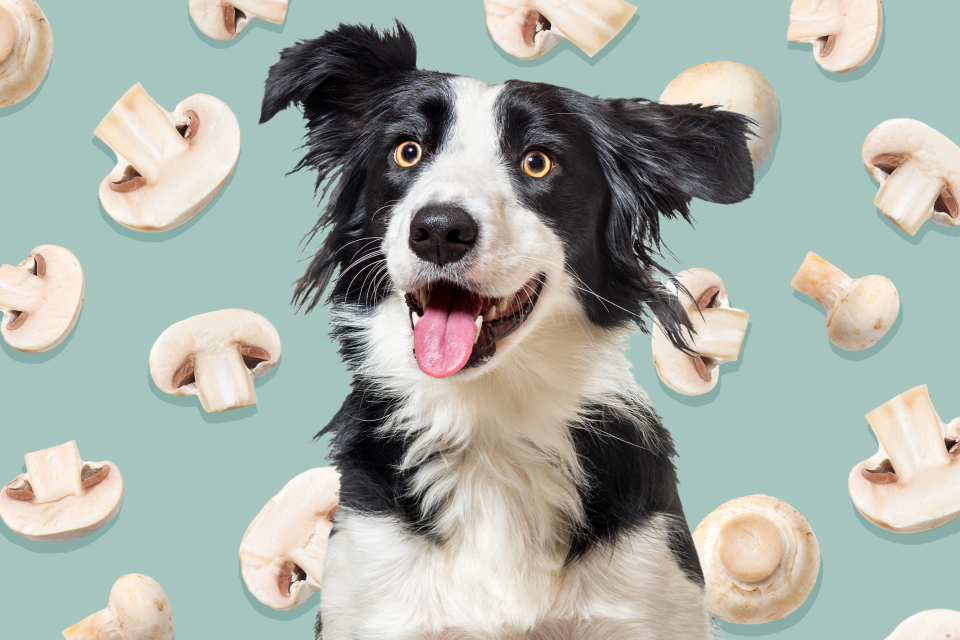Can Dogs Eat Mushrooms?
Pet parents are all too familiar with their dogs sniffing (and sometimes eating) weird things in the yard, on a walk, or on a hike in the woods. And sometimes, mushrooms can pop out of the ground where you least expect them.
But is a frantic visit to the emergency room necessary when your dog eats a mushroom?
Not necessarily, says Renee Schmid, DVM, DABVT, DABT, a veterinarian toxicologist who works with Pet Poison Helpline. But if you're talking about wild mushrooms—not the ones from the grocery store or garden-grown—you'll need to get them identified so you'll know whether they're toxic or non-toxic if a dog eats them.
"Most, but not all, mushrooms that grow in someone's yard will cause a dog stomach upset, but because more toxic ones can sneak in, it's best to try to have the mushroom identified," Schmid says.

Dmytro / Life On White / Getty
Which Mushrooms Are Safe for Dogs?
Mushrooms bought from the store or grown in your garden for your human family members to eat are generally safe for dogs, Schmid says. These mushrooms show up as cuisine staples in dozens of common and uncommon dishes, including salads. Shiitake, portobello, white button mushrooms—they're all good.
"If a mushroom is safe for human consumption, it's OK for dogs too," she says.
But when it comes to the wild mushrooms that grow in damp parts of our lawns or landscaping, or the mushrooms we find under the trees in the woods, all bets are off. Many varieties of mushrooms join the long list of other toxic or unsafe plants for dogs, and the consequences of eating a poisonous mushroom are as dangerous for dogs as people.
Signs Your Dog Ate a Poisonous Mushroom
An upset stomach is common for dogs who eat a poisonous mushroom, but depending on the type of mushroom, the signs of poisoning could get much worse, says Schmid.
"Poisonous mushrooms are grouped into several different types," she says. "Some only cause stomach upset. Others can cause liver or kidney failure, seizures, tremors, and hallucinations. Another group causes excessive drooling and urination, vomiting, diarrhea, and tearing from the eyes."
That's a wide range of possibilities, and unless you're a mushroom expert, you might not know what you're dealing with.
RELATED: How to Make a Dog Throw Up
What to Do If Your Dog Eats a Mysterious Mushroom in the Yard or on a Walk
If your dog has eaten a mushroom, and you don't have time to check with a mushroom expert on whether it's poisonous or not, contact your veterinarian or a poison control number or website immediately for advice about what to do. The Pet Poison Helpline is (855) 764-7661.
You can't treat a mushroom poisoning at home, so you'll need expert help, says Rachel Hinder, a registered veterinary technician working at Embrace Pet Insurance.
"Mushroom toxicity should be taken very seriously and treated as quickly as possible," Hinder says. Pet insurance claims at Embrace for mushroom intoxication are most common in summer into early fall, with an average claim amount at the veterinarian of $633.
How do you prevent a bill like that?
Safety Tips for Dogs Around Wild Mushrooms
When it comes to keeping your pup safe from the threat of a toxic mushroom, experts say there are a few ways to help mitigate risks. Keeping tabs on your pet—especially ones who like to gobble up mystery "snacks" from the ground during walks or on romps in the yard—is a great start.
1. Check your yard for mushrooms.
If your dog enjoys eating anything that looks even remotely interesting, make sure your own yard is dog-proofed and clear of all potentially toxic plants. If your yard seems prone to mushrooms, make a sweep to clear them more often.
2. Supervise your dog on walks or hikes.
Do you and your dog like to go on adventures in the woods? Make sure to watch for mushrooms popping up in dark, damp spots where your dog likes to go sniffing and poking. Keeping your dog on a leash during hikes will help you keep her close so she doesn't go exploring too far on her own where you can't see what she's putting in her mouth.
3. Educate yourself on common mushrooms your dog might eat.
If you know some particular kinds of mushrooms pop up regularly in your area, Schmid recommends you hit up the experts. There are mycology and mushroom groups on Facebook as well as a page on the North American Mycological Association (yup, they study mushrooms) with contact information for local chapters. Staffers or educators at a college extension office, a greenhouse, or a garden center might also be able to help, she says: "They're often familiar with the mushrooms that are commonly found in their area."
4. Teach your dog to drop what's in her mouth.
Hinder says education starts with you, but continues with your dog, and says that teaching your pup the 'drop it' cue "can be life-saving when it comes to them putting something like a wild mushroom in their mouth."
How to Feed Mushrooms to Your Dog Safely
If you still want to let your dog try a mushroom—the non-toxic kind that are also safe for humans, that is—Schmid says "no worries." In general, store-bought and garden-grown mushrooms that you eat are safe for canine consumption. Wash potential pesticides off them first and don't mix them in unhealthy recipes or with other toxic ingredients to share with your dog. Then chomp away.
But there's not much reason to give your dog a 'shroom, according to Hinder: "Mushrooms don't provide any nutritional value to dogs though, so there's no reason to purposely feed them to your pets."
If you and your dog want to share a mushroom on occasion, awesome. But since they don't offer any nutrients for your pupper, maybe pick a new, even more nutritious human food to share together instead.

